Deer-resistant cottage garden of Freda Cameron
During my recent vacation in North Carolina, my dad and I had the pleasure of visiting the garden of Freda Cameron and her husband in Chapel Hill. I’ve long been a reader of Freda’s blog, Defining Your Home, Garden and Travel, which is a great source of information about gardening with (or rather gardening to thwart) deer and rabbits. Pictured above, from her gorgeous cottage garden, are Verbena bonariensis and beebalm (Monarda) in full bloom.
Freda’s home is on a large country lot that gives her garden a bucolic backdrop.
The welcome to her charming home begins before you reach the front porch. A generous entry garden is enclosed by a wrought-iron fence, keeping out the numerous deer. The garden flows through the fence and extends outward, giving Freda more room to garden, albeit with deer-resistant plants.
Here’s the main approach to the garden, a curving flagstone path. A stepping-stone path diverges to the right, leading through the portion of the garden outside the fence.
Inside the fence, the sunny garden is bisected by a stream crossed by an arching wooden bridge. A gravel path leads past Knock Out roses to a bench tucked under a willow.
It’s a charming space—to my mind, a sister garden to Jenny Stocker’s garden (Rock Rose) here in Austin.
Freda (pronounced Fred-uh) commented that her garden is between spring and summer bloom cycles now, but there was still much in flower.
Freda and her husband, who helps out with the heavy lifting, recently changed out their “Chapel Hill grit” paths (similar to Austin’s decomposed granite) for river rock to cut down on weeding chores. Her before-and-after images and explanation of how they accomplished the work are a great resource for anyone considering a similar change.
The gravel path curves past the bench, crosses the wooden bridge, and leads to an enticing, gray-green gate set in an extended wall of their house. A butterfly bush in full flower will stop you in your tracks.
I love Freda’s gate. Notice the “peekaboo” slats that give you a glimpse of what’s to come.
On the other side of the gate is a side garden with a dining patio and an intimately scaled waterfall, which feeds the stream that flows under the fence into the entry garden.
The dining patio. Outside of the fence, this part of the garden is open to deer, and Freda said they’ll come right up on the patio to drink from the waterfall and stream.
Turning back to the gate, this beautiful framed view presents itself.
The rest of the garden, released from the confines of the fence, pools outward in a broad semi-circle, offering up cottage-garden perennial color like coneflower, yarrow, beebalm, butterfly bush, salvia, and more. Ornamental trees add vertical interest, like the purple-flowering vitex.
Rose campion and agastache make a delightfully rosy combo.
I love a stand of Verbena bonariensis in a garden, and Freda’s captivated me for a long photo op. Here it mixes with bronze fennel, a combination I would love to replicate in my own garden. (Am I the only person who can’t seem to grow this verbena from seed? I’ve tried several times, with no success, so I’m planning to set out pots of it this fall.)
Here it is with beebalm (Monarda), an enchanting pairing.
Who can resist this airy summer bloomer? Not me.
I also love her tomato-red beebalm, with its crazy mop-top hairdo.
Freda doesn’t go in for a lot of garden art, but she added a bit of color to this metal tuteur by painting it purple. A hyacinth bean vine will add its own purple when it starts to bloom.
Love-in-a-mist had already finished blooming, but the seedheads are interesting.
Enormous butterfly bushes (Buddleia) help screen the driveway and parking area.
Freda and her husband recently redesigned the guest parking area and dressed it up with this welcoming bench and potted plants. Her challenges: baking sun in summer, wet soil in winter, and washed-out gravel, not to mention the difficulty of creating welcoming, human-scaled garden spaces on a huge, open lot. It’s another of her blog’s wonderful before-and-after posts; check it out.
Many thanks for the delightful visit, Freda and the Musician (her husband)! We enjoyed your hospitality and seeing your beautiful garden in person. For more about Freda’s garden, check out her blog at Defining Your Home, Garden and Travel.
All material © 2006-2011 by Pam Penick for Digging. Unauthorized reproduction prohibited.


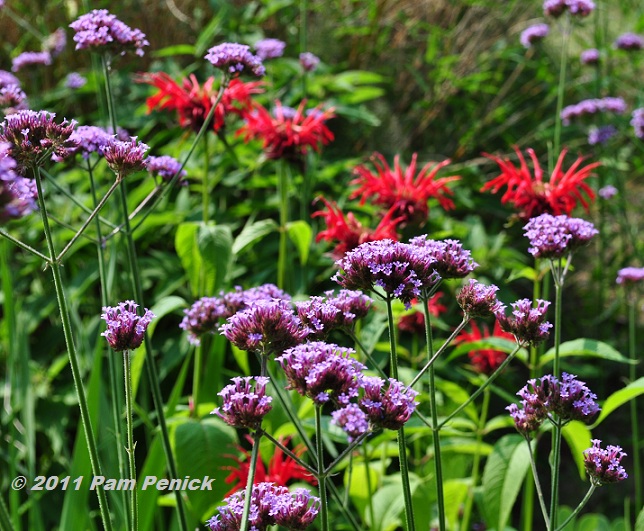
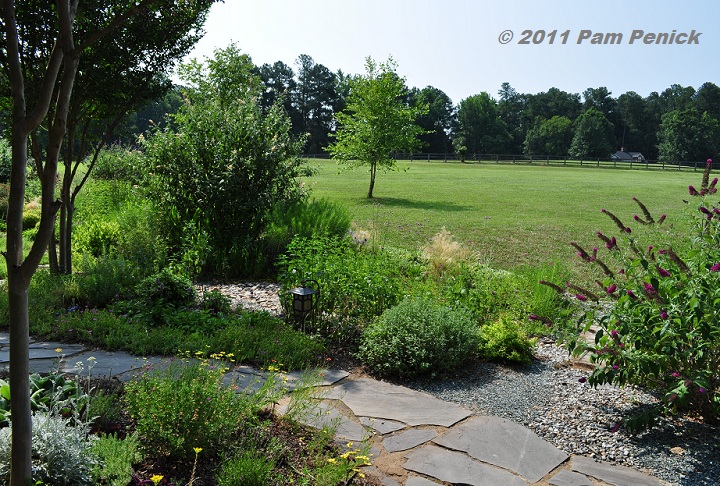

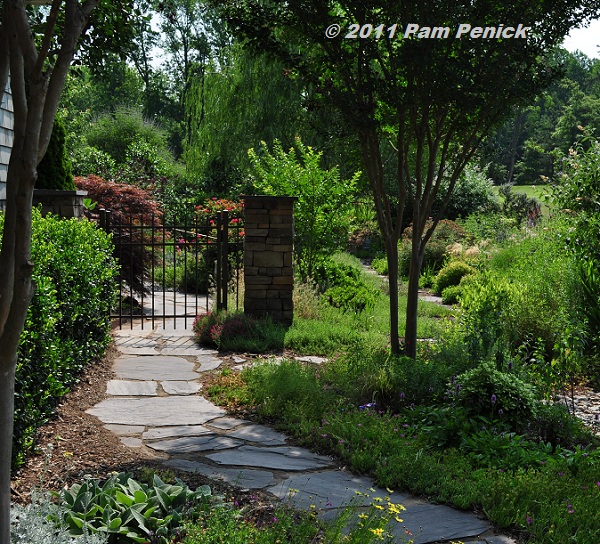
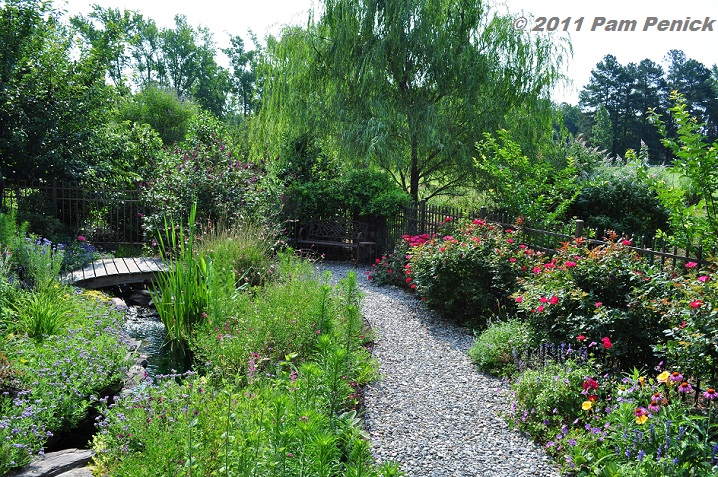
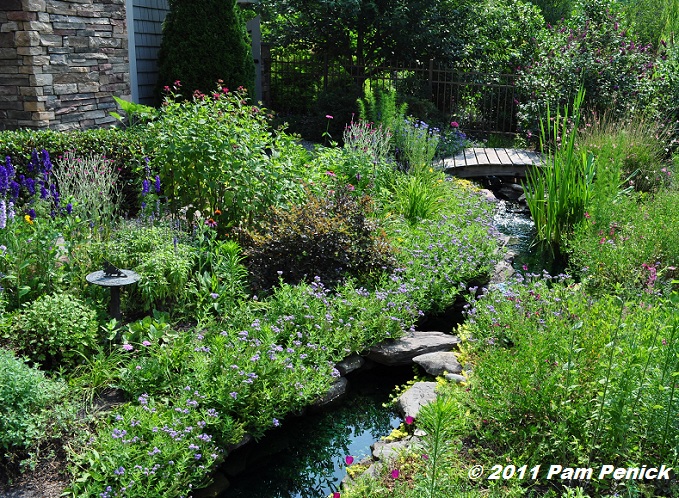
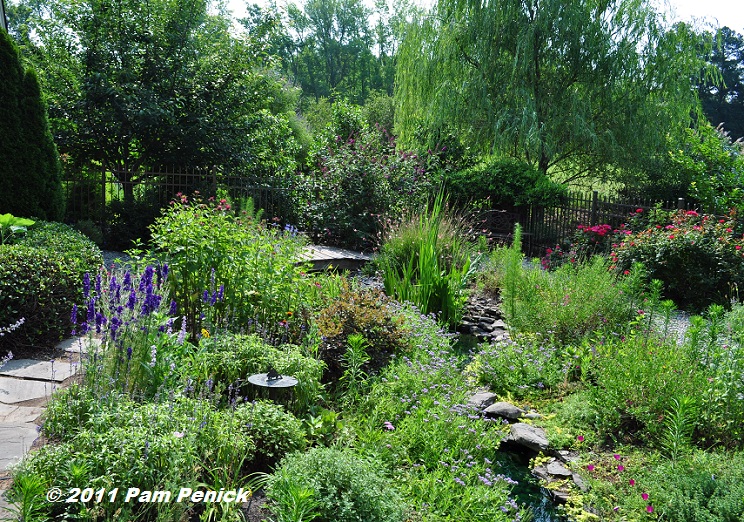
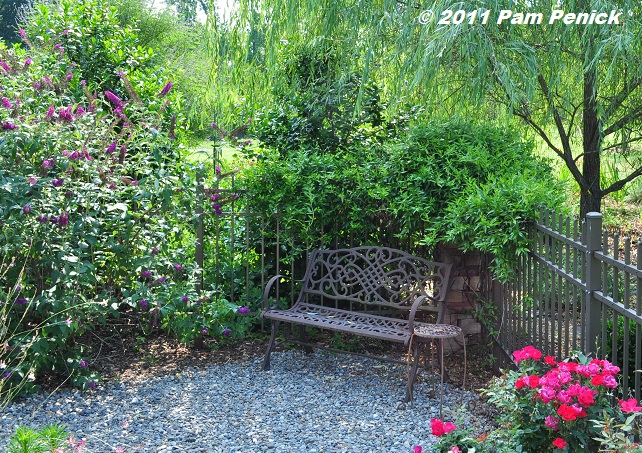
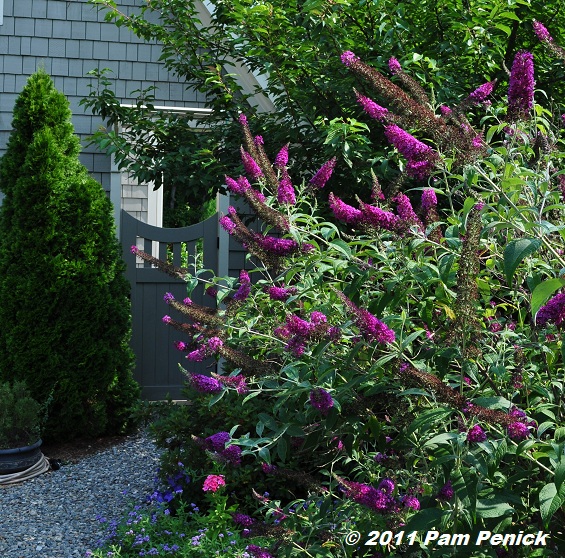
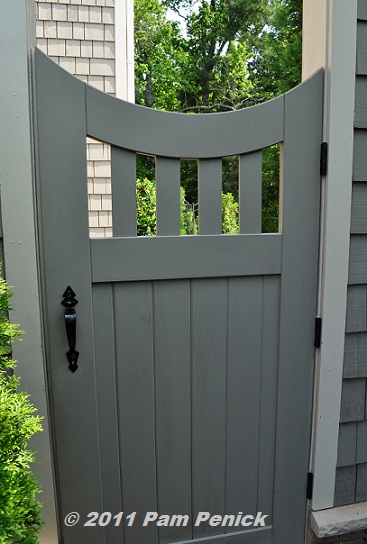
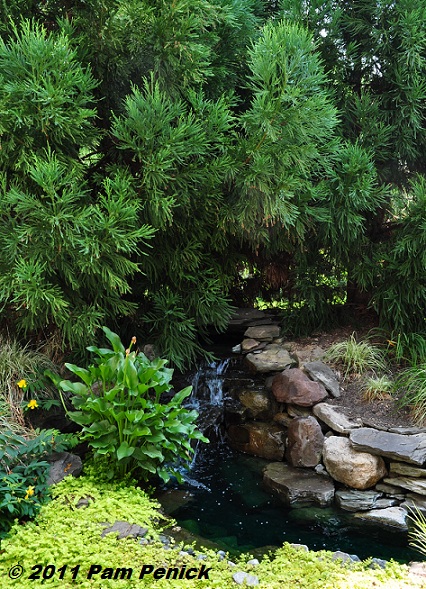

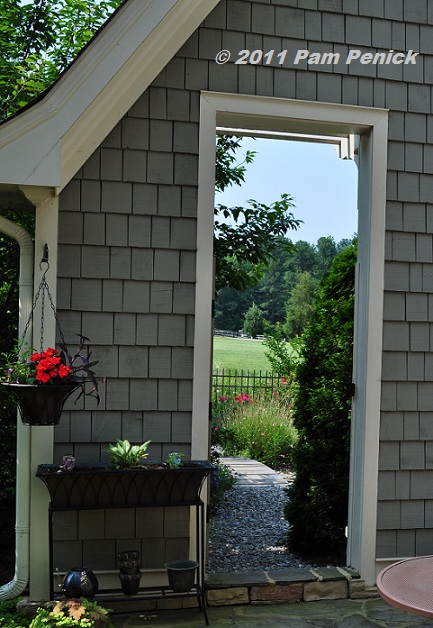
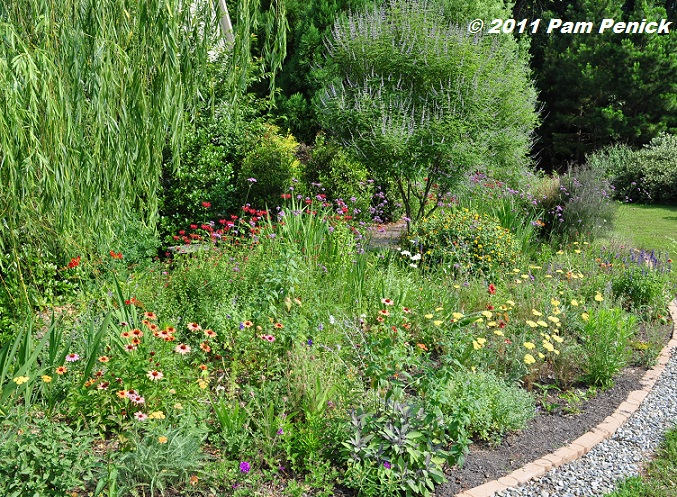

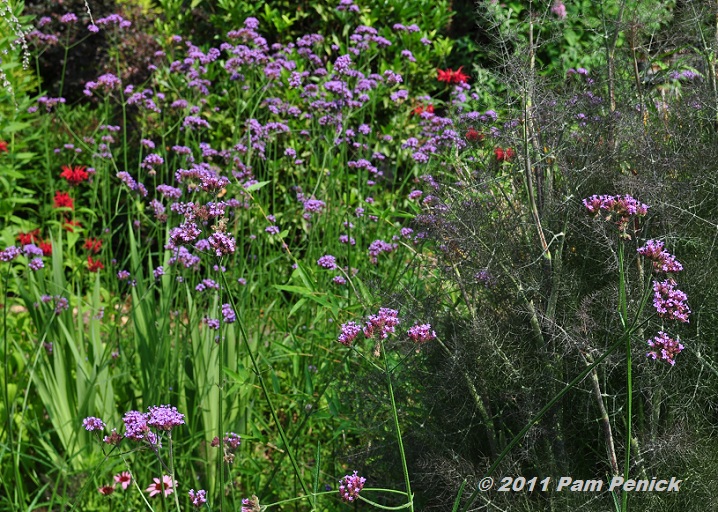
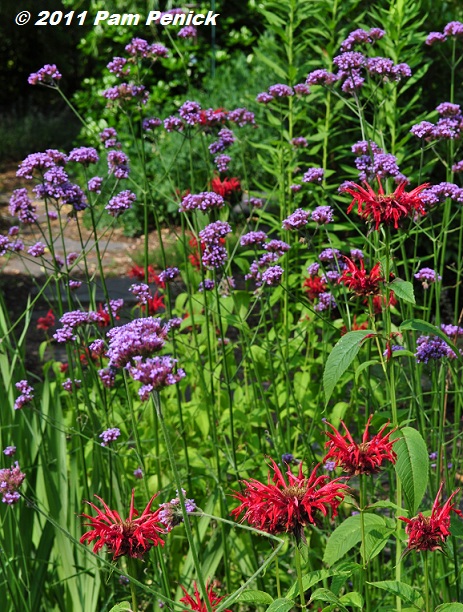
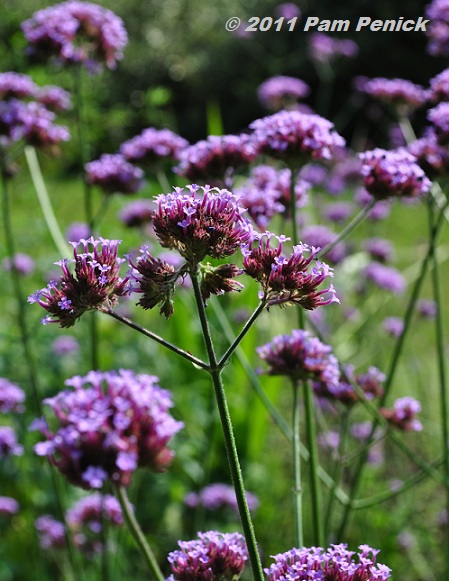

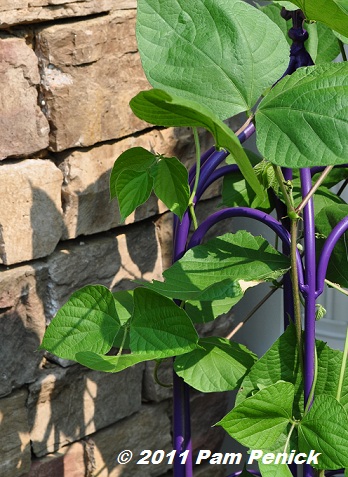
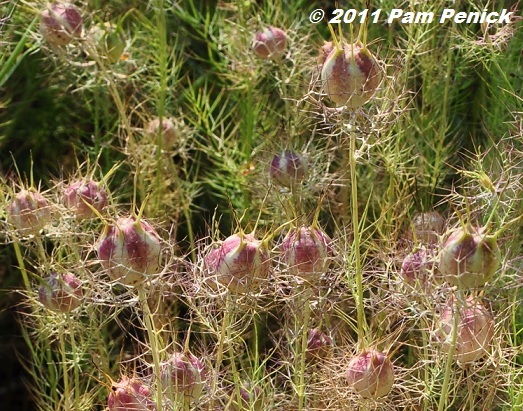
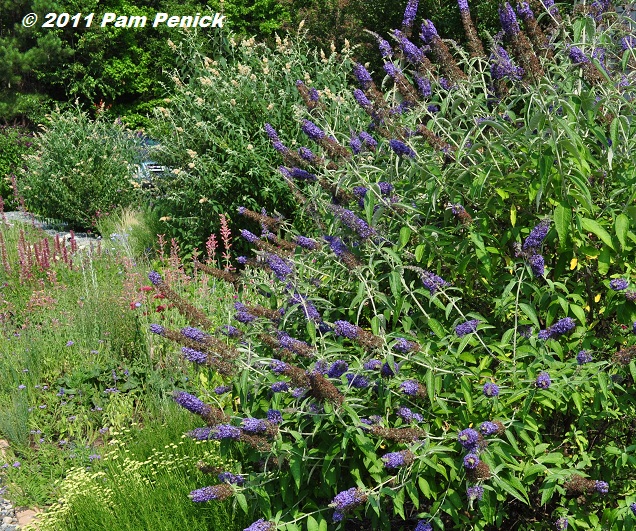
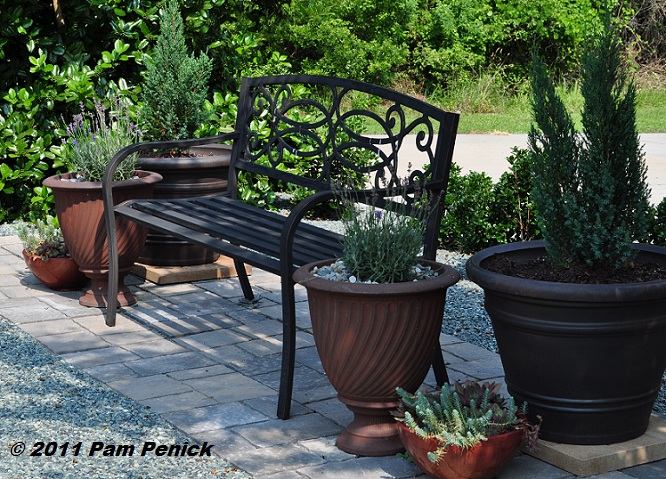
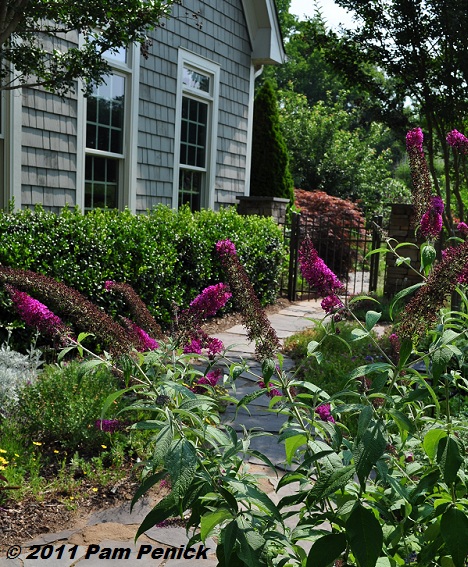
Pam, what a gorgeous place and you’ve captured it beautifully. I want bee balm! How is your newly planted one faring in this heat? I’m anxiously await your end of season report on it before I plant one. I don’t know that this year is a fair test of it, though. Fabulous post.
Gorgeous garden! You can tell it rains there…
The latest “deer don’t eat this” plant to be browsed in my yard is Mexican Tarragon.
Love her house. Fabulous curb appeal with that porch and that chimney. Nice.
To folks who are battling deer: Please note that her wrought iron is a strong deterrent – mostly because the ‘landing’ space inside it is narrow and the ‘stream’ depth unknown, deer won’t willingly jump into a space where they might be injured – in times of extreme stress on the deer herd, this will not keep them out.
Fabulous opening pic, Pam. !Adore!
Jenn
Hi Pam,
Thank you so much for your kind words. My husband and I were delighted to have you and your father visit us.
Freda
PS A note to Jenn’s comment — you are so right, the deer cannot see a way out of that fence because the house forms an L-shape on two sides and the fence is on two sides. They sail over or crawl under the three-board fences used in our neighborhood (visible in 2nd photo). The outer gardens, where the deer literally live (a fawn sleeps beneath my gladiolus, verbena and bee balm) is heavily planted with salvia, agastache, buddleia, verbena, milkweed, spirea, lavender, rosemary, gaillardia and more.
Pam, I think you might be the only person who can’t grow verbena by seed. I was thinking of this about myself, as last year I let all my store-bought verbena go to seed and waited patiently throughout the spring for seedlings to appear. Then all of the sudden, overnight and all at once, 5 million+ seedlings appeared – everywhere. I am still pulling out seedlings on a daily basis. This year I will not let it all go to seed and have postioned the verbena carefully in anticipation of next year’s crop. Good luck.
I’ve been following Freda’s blog for some time. I always gravitate to anything that will teach how to garden with deer. She grows some things outside the fence that our deer would chomp. Maybe hers is planted heavily enough with other things to deter them.
It was good to see her garden through your eyes and lens.
Thanks…
Another gem of a garden. Love that waterfall and stream flowing through the garden.
You had quite a trip. This lovely garden is a ‘must see’ and I did sense your joy at the agave collection at Plant Delights. How did you get those home? 🙂
I glued them all over the outside of the car. 😉 Truthfully, I brought home only 6 plants and stuffed them in among the luggage, and hauled them in and out of two hotel rooms. What we won’t do for plants, eh? —Pam
This is a stunning garden!
What an enchanting garden! Love the pictures!
Pam – Verbena bonariensis was a must-have plant for me once I saw it, and it seemed to start from seed pretty easily. Unfortunately it gets covered in powdery mildew here in St. Louis (as does bee-balm — interesting that you show them both together) so I’ve not actively planted it again. I still have volunteers popping up all over the place though. Maybe you should scatter some seed this fall and see what happens in the spring. 🙂
How inviting this all looks. Her home are gardens are so charming.
I am familiar with Freda’s blog and enjoyed immensely seeing it through your camera and your eyes.
If you can find someone who will give you some dry heads off their Verbena on a Stick, just scatter them where you want them. Sometimes the whole head works better than scattering cleaned seeds. If you can get ONE to grow, they will return, perhaps not where you intended but they’ll be there. Mine tend to redefine the perimeters of the bed they were in. If they get powdery mildew just whack them back to the ground.
Thanks for taking us on a virtual tour of this incredible garden!
Pam, I found you on Twitter. I really enjoyed strolling through Freda’s garden via your photos. Inspirational to a novice flower gardener like myself. Thank you!
I’m with those above who have the verbena reseeding quite freely– just dug some volunteers up for my Dad. I recently posted about how much my bees love it. I’m trying to grow that red beebalm for the first time, and no matter how much I water, it’s straggly and crispy. Must relocate to some afternoon shade.
Try Monarda ‘Peter’s Purple,’ Lisa bee. It was trialed under duress in Dallas and is doing well in hot, droughty Austin. —Pam
HI, I read your comment on Gardening gone wild (quite lame actually) and wholeheartedly agree with your comment to Noel (eric) Kingsbury..he is rowing his own commercial boat like all the rest on that forum..I for one find USA gardens to be very refreshing compared to the UK..they ain’t had any idea’s of their own for decades!
Love you photo’s..shame its not prairie..biff wallop!
Best
Billy
Hi Pam, I just clicked on the link to this post from Freda’s blog. I love your photos of her place! How cool that you and your dad got to go there, and now you are in Seattle! I had hoped to go this year, for my first fling, but with having the tree cut down, and filling up the area with plants, I couldn’t manage the expenses of it. One of these years, I hope to make it.